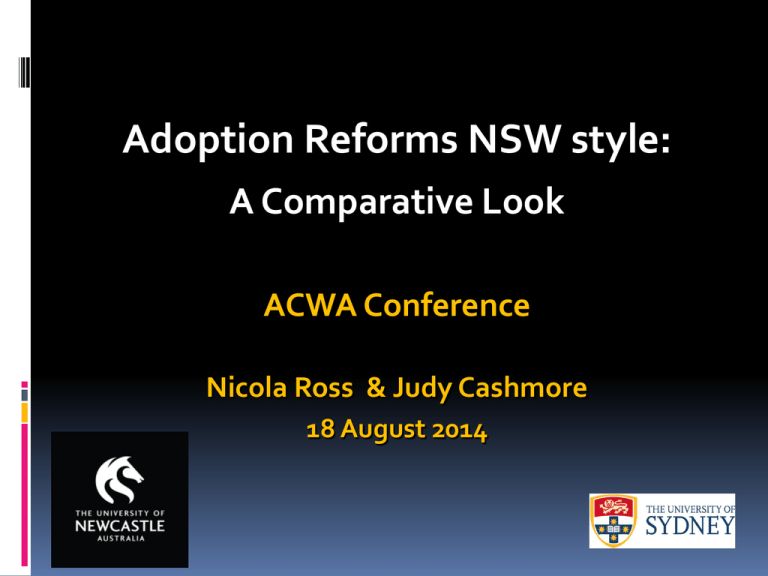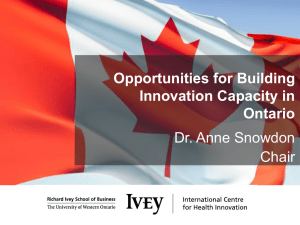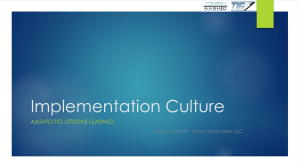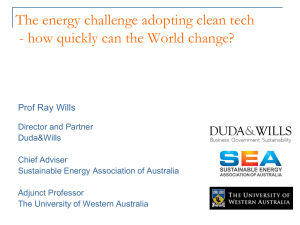Ross
advertisement

Adoption Reforms NSW style: A Comparative Look ACWA Conference Nicola Ross & Judy Cashmore 18 August 2014 MAIN THEMES Need for reform - continuing tension between the child’s right and need for secure LT family for life and parent’s capacity to ‘become’ good enough parent What approaches have other countries taken? And changes over time to current approaches? Pros and cons? What do we know re adoption and foster care outcomes ? Transferable? Research issues … What works best for children – and their views? Why the need for reform? Continuing evidence that many children in care do not have stability and are not doing well in care and after care Need for new approach to permanency Increasing numbers of children in care and shortage of foster carers Need for new source of carers and opportunity for children in certain circumstances to be adopted by foster carers Numbers of children in care Rate per 1000 Time A Rate per 1000 Time B Australia 3.3 1999 7.8 2013 England 4.5 1994 5.5 2009 Canada 4 1991 9.7 2007 US 8 1997 6 2007 Sweden 6 2000 6.6 2007 Norway 5.8 1994 8.2 2008 Belgium 7.9 2004 8.6 2008 Germany 9.5 1995 9.9 2005 Netherlands 8.4 2000 10 2009 Denmark 9.5 1993 10.2 2007 8 1994 12 2007 Finland Gilbert et al (2011) Reasons for low adoption rate Cultural attitudes to adoption – Stolen Generations, Forgotten Australians Greater focus on kinship care Loss of foster care allowance and other entitlements Caseworkers’ lack of time, resources and skills to discuss with parents and process adoptions in Supreme Court Costly court proceedings if parent does not consent to adoption – not wanting to be seen to relinquish or ‘reject’ child Children’s resistance - not wanting to relinquish family ties Replacement by guardianship or permanent care orders eg Vic NSW Hierarchy 1. Restoration to parents UK 1. Restoration to parents US 1. Restoration to parents 2. Long-term 2. Legal Guardianship 2. Adoption guardianship to 18 Special Guardianship to relative or kin 3. Adoption (open) 3. Adoption 3. Legal Guardianship 4. Parental responsibility to the Minister 4. Residence Orders 4. Permanent Placement with a fit and willing relative 5. Get rid of this box 5. Get rid of this box 5. Another planned permanent living arrangement. Adoption by relatives Guardianship Order Open adoption Concurrent adoption Fostering for adoption Preference for adoption over kin Subsidised adoption % adopted out Australia (NSW) United Kingdom United States No No Yes Decreasing ? NSW No No No No Yes, after parents No Increasing subsidies Significant to states & individuals Very low now 13% 20% Australia (NSW) Supported adoption % of kinship foster care Subsidised kinship care % in foster care Subsidised foster care Children leaving care – ‘freed’ but no adoption ? United Kingdom Increasing supports Greater for non-kin – see C&FA 2014 adoptive carers 47% 11% (56% NSW) but increasing SGOs yes, but Minimal often no orders so no funding Increasing Increasing √ United States √ Currently numbers Not yet of children awaiting 27% ↑subsidised kin care/ informal arrangements Increasing funding of guardianship (often kin) Decreasing √ 11% + Selwyn & Masson 2014 No of children Adoption Special Guardian/ ship Orders Residence Orders 37,335 5,912 5,771 Av age at ‘entry to care’ 14 months Time to final placement Longest – children aged 4 yrs on average On average aged 5 yrs 3.2% over 12 years 5.6% over 5 year period Disruption rate When 2/3rds during teen years 3 yrs 4 mths 4 yrs 5 mths On average aged 6 yrs 25% over 6 year period Within 2 years - esp if not kin Philosophical tensions and issues No easy answers - long-standing debate between – child’s need for stability and timely decision-making – parents’ need to meet demands for ‘good-enough’ care Tension foremost in time-frames Dispensing with consent of birth parents UK Courts – recent cases require ↑ in quality evidence – may create tension with government policy to speed up adoption Need for post-adoption support – forecasting problems vs assuming families will cope privately and not require support Purpose and efficacy of contact issues – reduced in UK Role of research evidence – appropriate translation Trends in the US & UK US, UK and Australia are all advocating “permanency” In Australia (NSW) we are moving to a public health model of child protection, which suggests a focus on primary care & prevention, family support US approach heavily favours adoption as a solution, but new emphasis on kin care subsidies and services to restore children to families. Reducing numbers in care not only due to adoption: some children never adopted. UK heavily focused on adoption as means of securing permanency (↑numbers and speed) – but evidence tension with courts in their traditional role of providing checks and balances on state intervention into family. Recent English Cases in tension with UK government policy on adoption Recent Supreme Court cases of Re B (Care Proceedings Appeal) [2013] UKSC 33 , followed by Court of Appeal cases of Re B-S (Adoption: Application of s 47(5)) [2013] EWCA Civ 1146 and Re S (Appeal from Care and Placement Orders) [2014] EWCA Civ 135 – Court focus - limits adoption to a ‘last resort’ (fundamental reappraisal of adoption as a child protection mechanism & proportionality requirements) Increased scrutiny of social work evidence to support this in comparison to other options for care (↑ delay) Lowering leave hurdle for parents to have a placement order revoked or to contest adoption Permanency 3 forms of permanency: legal, emotional, physical Trust, feeling loved, cared for – sense of security makes the difference at the individual level Children’s perceptions that matter Relationships esp with parents and caregivers mediate the effects of structural variables Social support – family level Permanency: a narrow legal construct? Criticism of the US construction of permanency as equated with narrow legal concepts of adoption Permanency equated in social sciences approaches to the sense of security a child has that they belong in a family – not severance of legal ties to birth family Adoption developed as a private law concept in 20th century in context of consensual decisions; now key mechanism in public law, coercive state intervention Adoption concept needs legal renovation; danger of not recognising the new context in which it operates and overemphasising it as a panacea Focus of Adoption Research Focus on outcomes, identity and contact between members of child, adoptive and birth parents Relatively few studies directly with children re their experiences Reliance on UK and US research – little in Australia Not a singular experience – diversity and different contexts Differences between : Local and intra-country adoption ‘Known’ and ‘unknown’ adoptions and Adoption by foster carers and other unknown Challenges in trans-racial adoption Adoption Research Focus on outcomes, identity and contact between members of child, adoptive and birth parents Relatively few studies directly with children re their experiences Reliance on UK and US research – little in Australia Not a singular experience – diversity and different contexts Differences between : Local and intra-country adoption ‘Known’ and ‘unknown’ adoptions and Adoption by foster carers and other unknown Challenges in trans-racial adoption Factors affecting adoption and LT foster care outcomes Age at placement – expectation re age of child Time in care and number of earlier moves Severity and duration of abuse and neglect Children’s emotional and behavioural problems Carer’s age, commitment and resources Child’s wishes – ambivalent or opposed Presence of other children Children of carer near age or less than 5 years Siblings / other foster children Research issues Somewhat mixed picture: Issues to consider Comparing ‘like’ with ‘like’ – selection and ‘survival’ biases Correlation vs causation – Nature, size and quality of sample – national rep studies Going beyond disruption rates Outcomes - quality of relationships and felt security Whose reports? Hearing from children Best evidence – longitudinal studies Pathways of Care study – NSW important opportunity Beyond 18 – Vic larege-scale longitudinal study NSW Pathways of Care study http://www.community.nsw.gov.au/pathways/index.htm Children’s Rights Issues Children’s right to a family – balance Best interests and rehabilitation as primary objective Children’s rights to family, to identity and to be heard and to participate Regular (independent) evaluations of practices, programs * UN Committee Concluding Observations Policy Implications Importance of varied options to meet needs of particular children : adoption no panacea for all but can meet needs of very young children if undertaken early (research evidence) It is an important option for children, but risk it will be favoured because of resource implications in difficult fiscal times; not because it is only option for individual children Introduction of adoption as preferred approach needs to be evidence-based and accompanied by support








